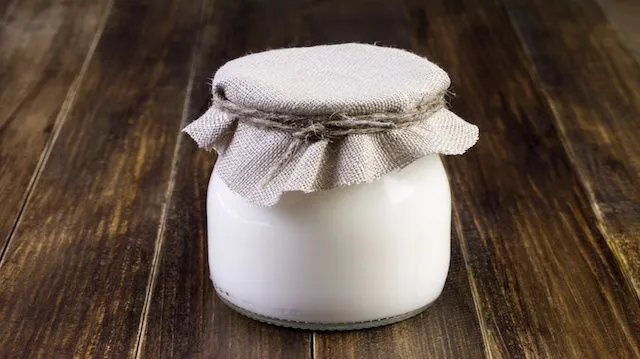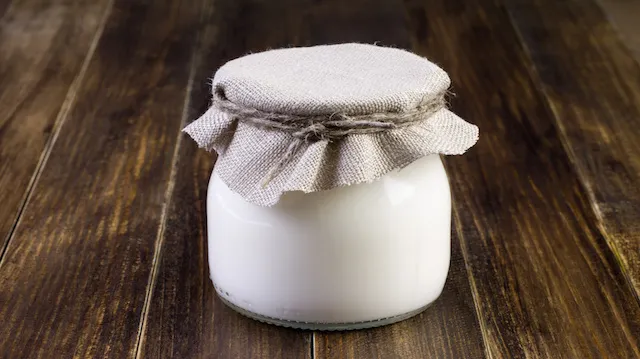
- Share on Facebook181
- Share on Pinterest
- Share on Twitter
Our immune system, which is housed in the gut for the most part, fights off toxic bacteria around the clock to keep us well. The best way to help your body fight off toxins and bad bacteria from certain foods and the environment is to first establish a healthy diet, and next, add probiotic-rich foods to your diet. And no, sorry, that doesn’t include those fun, flavored yogurts at the store, which are full of sugar and chemicals, not to mention GMOs and other unhealthy ingredients.
Let’s try one of nature’s most powerful probiotic-rich elixirs instead.
Kefir: one of the most beloved fermented foods of all time
Fermented foods have been around for thousands of years and are used as a way to enhance digestion and preserve food. Kefir is one of these foods; it is regarded as a true superfood in many countries. Kefir is different from yogurt, which is cultured with certain sources of good bacteria. Instead, kefir is made when kefir grains are added to milk, or another liquid with fermentable properties. Although they are called “grains,” kefir grains are not actually a grain at all; they are cultures of bacteria formed together to create a beneficial yeast. Kefir grains are 10 times higher in probiotics than yogurt, and most kefir beverages contain anywhere from 10 to 12 billion probiotic cultures per serving.
Probiotics have been shown to…
- reduce candida overgrowth
- cleanse the digestive tract
- promote a healthy immune system
- relieve depression
- help to fight off the common cold and even chronic forms of disease
- maintain a healthy digestive tract
- help with nutrient absorption
- enhance mental clarity
- enhance and nourish the skin
- reduce skin fungal infections
- reduce vaginal yeast infections
- speed up transit time in the digestive tract
- combat IBS and bloating
These are just some of the benefits most commonly reported with implementing kefir into the diet. It has also become one of the top recommended products for leaky gut syndrome and IBS. While kefir made from organic, grass-fed cow’s milk is a great choice for most people, others are sensitive or intolerant to dairy, which makes cow’s milk kefir out of the question.
Benefits of using almond milk kefir
Thankfully, there are other options you can choose that are 100 percent free of dairy. Some of these include water kefir and coconut water kefir. You can use coconut water to make your own kefir, but for a beverage that’s closer to the taste of dairy and a bit more creamy, almond milk is an easy, delicious alternative.
I’ve been making my own almond milk kefir for years for two reasons:
- Almond milk goes bad fairly quickly and is prone to mold if not kept well.
- It’s so easy and convenient to make, and I love the flavor it produces.
 Almond milk kefir will keep up to a week in the fridge because the healthy bacteria in the kefir preserve it, unlike regular almond milk that goes bad in 2–3 days if not stored well. You can also freeze the kefir into cubes if you like to use in smoothies, just like you would regular almond milk.
Almond milk kefir will keep up to a week in the fridge because the healthy bacteria in the kefir preserve it, unlike regular almond milk that goes bad in 2–3 days if not stored well. You can also freeze the kefir into cubes if you like to use in smoothies, just like you would regular almond milk.
Almond milk kefir can also be used in place of buttermilk as a dressing if you make it extra thick by using less water than the recipe calls for. It can be used on top of a grain-free porridge or in smoothies mixed with some cinnamon and ginger for a digestion-friendly tonic.
|
Almond Milk Kefir
|
| Prep Time: |
| 2days |
| Cook Time: |
| nocook |
| Total time: |
- 2cups organic raw almonds(Always choose organic to avoid chemicals and pesticides and never use pasteurized, salted and/or roasted almonds since they will not ferment or sprout well.)
- 1teaspoon honey, 1 date or 1 dried fig(This is merely used to feed the kefir grains and allow them to grow. The grains need a source of sugar to start the fermentation process, but never use refined sugar or agave. There is no sugar in the final product because the kefir grains eat up all the sugar during fermentation.)
- 4cups cold, filtered water
- 1 dairy-free kefir starter(Or, after you make your first batch, you may use 4 teaspoons of your previous kefir batch.)
- A large ceramic or glass bowl, or crock (enough to hold 8 cups of water)
- A cold oven (yes, really!)
- A high-speed blender
- To make this kefir, all you have to do is follow the recipe for regular almond milk: Soak the almonds overnight covered in cold, filtered water. In the morning, blend them in a high-speed blender with the 4 cups of cold water. (Be sure to blend thoroughly, about 2 full minutes.)
- Strain the mixture through a nut milk bag, a cheesecloth, or a fine sieve over your glass bowl.
- Reserve the nut pulp for a later use, or discard if you like.
- Rinse out your blender thoroughly.
- Add the almond milk from the bowl back into the blender and then add the culture starter (or 4 teaspoons of your previous batch of kefir).
- Add the honey, date, or fig.
- Blend for a full 2 minutes. You want to do this so that the blender heats up just enough to warm up the cultures, but not so long that you overheat the blender. Two minutes seems to be the perfect time. Other recipes may require that you warm the milk on the stove. Using the blender to warm the milk means you can skip this step.
- After 2 minutes, simply add the milk back to your bowl.
- Cover the bowl with a large towel making sure to wrap it tightly so that the towel doesn’t fall into the liquid. You want to think of this process as wrapping it and incubating it.
- Place it in a cold oven (that’s been off for at least 12 hours).
- Let it sit in the oven with the light on for at least 24 hours.
- When you come back, you will have kefir!
Tips: Be sure that your kefir smells like traditional yogurt/kefir. It should have that fermented, tangy smell and should not smell like old milk or mildew. I’ve never had a batch come out spoiled, and it always turns out perfectly when I follow the steps above.
Keep the kefir in the fridge and enjoy in your next smoothie. Alternatively, use it on top of a grain-free or soaked oat porridge (do not heat), or in any uncooked recipe of your choosing. I personally love it first thing in the morning after a green juice for healthy cleansing and ultimate probiotic-support.
Storage: It’s best to store your kefir in a glass container such as a milk jug or a mason jar. Be sure not to store it in a plastic container, since the bacteria in the kefir will absorb unhealthy toxins in the plastic. Keep it in a cold spot in the fridge and enjoy for up to 7 days. Feel free to make yours thicker or thinner, but I wouldn’t suggest using more than 5 cups of water to 2 cups of almonds.
So, now you might be asking, how does this probiotic-rich beverage compare to probiotic pills or store-bought kefir?
Why not just take a probiotic supplement instead?
The truth is, if made correctly using a quality starter, making your own probiotic-rich foods like kefir can actually be much better for you. Think about all the processing that a product goes through, how long it sits on the shelf, and the price you pay for convenience. Though many products on the market are fantastic, there’s no way for us to measure how much bacteria we’re actually getting per product — and we can end up spending a great deal of money trying to find the best one. By making your own kefir, you can guarantee quality and value for money!
—Heather McClees
Heather McClees is a professional health journalist and Certified Holistic Nutritionist from South Carolina.She received her B.S. Degree in Nutrition Science and Dietetics, and is most passionate about helping others discover the gift of of holistic health, showing others how to create healthy recipes based on their favorite foods, physical fitness and yoga, and creative writing.
Sources:
http://draxe.com/kefir-benefits/
http://bodyecology.com/articles/the-link-between-homemade-kefir-and-your-immune-system
http://microbialfoods.org/science-digested-exploring-kefir/
http://www.ncbi.nlm.nih.gov/pubmed/21390946
http://www.culturesforhealth.com/buy-water-kefir-grains.html
http://bodyecology.com/digestive-health-kefir-starter.html
http://www.thecandidadiet.com/kefir.htm
- Share on Facebook181
- Share on Pinterest
- Share on Twitter

